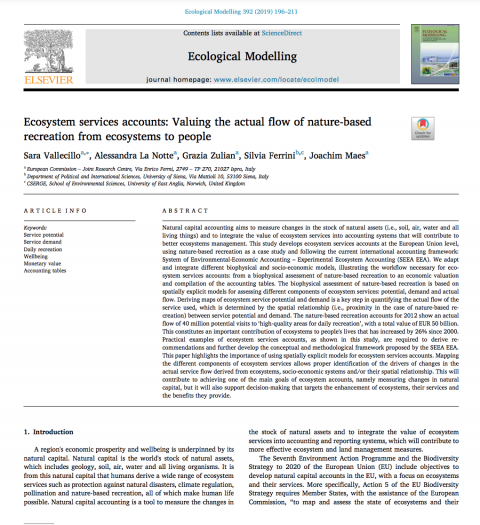Ecosystem services accounts: Valuing the actual flow of nature-based recreation from ecosystems to people

Document Summary:
Natural capital accounting aims to measure changes in the stock of natural assets (i.e., soil, air, water and all living things) and to integrate the value of ecosystem services into accounting systems that will contribute to better ecosystems management. This study develops ecosystem services accounts at the European Union level, using nature-based recreation as a case study and following the current international accounting framework: System of Environmental-Economic Accounting – Experimental Ecosystem Accounting (SEEA EEA). We adapt and integrate different biophysical and socio-economic models, illustrating the workflow necessary for ecosystem services accounts: from a biophysical assessment of nature-based recreation to an economic valuation and compilation of the accounting tables. The biophysical assessment of nature-based recreation is based on spatially explicit models for assessing different components of ecosystem services: potential, demand and actual flow. Deriving maps of ecosystem service potential and demand is a key step in quantifying the actual flow of the service used, which is determined by the spatial relationship (i.e., proximity in the case of nature-based recreation) between service potential and demand. The nature-based recreation accounts for 2012 show an actual flow of 40 million potential visits to ‘high-quality areas for daily recreation’, with a total value of EUR 50 billion. This constitutes an important contribution of ecosystems to people's lives that has increased by 26% since 2000. Practical examples of ecosystem services accounts, as shown in this study, are required to derive recommendations and further develop the conceptual and methodological framework proposed by the SEEA EEA. This paper highlights the importance of using spatially explicit models for ecosystem services accounts. Mapping the different components of ecosystem services allows proper identification of the drivers of changes in the actual service flow derived from ecosystems, socio-economic systems and/or their spatial relationship. This will contribute to achieving one of the main goals of ecosystem accounts, namely measuring changes in natural capital, but it will also support decision-making that targets the enhancement of ecosystems, their services and the benefits they provide.
Link to an External Document:
